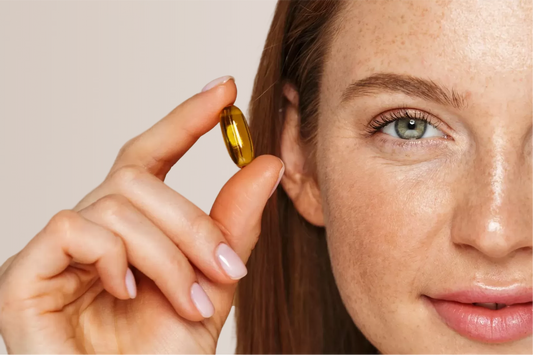what good fats do in your body
Have you ever wondered why dietary fats have such a bad reputation? For years, we've been told to avoid fats at all costs, but recent research reveals a more nuanced truth. Not all fats are created equal, and some fats are actually essential for our health.
In this blog, we will explore what good fats do in your body, specifically how avoiding trans fats, limiting saturated fats, and incorporating essential polyunsaturated fats can transform your diet and enhance your overall well-being.
What are dietary fats?
Dietary fats are a type of macronutrient found in food that provides energy and supports various bodily functions. There are several types of dietary fats:
Saturated Fats
- Found primarily in animal products like meat, butter, cheese, and whole milk
- Some plant oils, such as coconut, palm, and palm kernel oil, also contain saturated fats
- Tend to raise LDL (bad) cholesterol levels and increase the risk of heart disease when consumed in excess
Unsaturated Fats
- Divided into monounsaturated and polyunsaturated fats
- Monounsaturated fats are found in foods like olive oil, avocados, and nuts
- Polyunsaturated fats are found in foods like safflower, sunflower, corn, and soy oil
- Help lower LDL cholesterol levels when replacing saturated fats in the diet
Trans Fats
- Formed through an industrial process called hydrogenation, which turns liquid vegetable oils into solid or semi-solid fats
- Found in fried foods, baked goods, margarine, and processed snacks
- Raise LDL cholesterol levels and lower HDL (good) cholesterol levels, increasing the risk of heart disease.
Good fats vs. bad fats
There are two main types of dietary fats: good fats and bad fats. Understanding the difference between them is crucial for maintaining overall health.
Good Fats
Good fats, also known as unsaturated fats, are beneficial for heart health and overall well-being. They can be further divided into two categories:
- Monounsaturated Fats: Found in foods like olive oil, avocados, and nuts, monounsaturated fats help lower LDL (bad) cholesterol levels while maintaining HDL (good) cholesterol levels.
- Polyunsaturated Fats: Polyunsaturated fats, including omega-3 and omega-6 fatty acids, are found in foods such as fatty fish, safflower oil, and sunflower oil. They can help lower triglyceride levels and reduce the risk of heart disease.
Bad Fats
Bad fats, which include saturated fats and trans fats, can have negative effects on health when consumed in excess.
- Saturated Fats: Found primarily in animal products like meat, butter, and cheese, as well as some plant oils like coconut and palm oil, saturated fats can raise LDL cholesterol levels and increase the risk of heart disease.
- Trans Fats: Formed through an industrial process called hydrogenation, trans fats are found in fried foods, baked goods, and processed snacks. They raise LDL cholesterol levels, lower HDL cholesterol levels, and increase the risk of heart disease and stroke.
It's important to note that while trans fats should be strictly limited, some saturated fats, such as those found in coconut oil, may have a neutral or slightly beneficial effect on cholesterol levels.
Learn how to reduce belly fat
11 simple solutions for good fats
Here are 11 simple ways to incorporate more healthy fats into your diet:
- Use mashed avocado as a condiment.
- Add nut butter to a smoothie.
- Drizzle olive oil and balsamic vinegar on your salad.
- Use seeds or nuts as toppings on salads and yogurt.
- Add olives to your pasta, salad, tacos, or pizza.
- Order the cheese plate.
- Choose salmon or trout.
- Nibble dark chocolate for a sweet treat.
- Top Brussels sprouts or other sides with a fried egg.
- Melt butter on steamed veggies.
- Snack on nuts instead of chips.
- Cook with olive oil, or try avocado, sunflower, or grapeseed oil
- Make your own mayonnaise instead of using store-bought
what good fats do in your body: Use fat to reach your goals
Using fat strategically in your diet can help you reach your health and fitness goals. Here’s how incorporating healthy fats can be beneficial:
Energy Provider
Fats are the most concentrated source of energy in our diet, providing 9 calories per gram. They are digested slowly, which means they can help you feel full for longer periods, reducing the likelihood of overeating or snacking excessively on less nutritious foods.
Nutrient Absorption
Dietary fats play a crucial role in the absorption of fat-soluble vitamins, including vitamins A, D, E, and K. Including healthy fats in your meals can enhance the nutritional value of your food, ensuring your body gets the vitamins it needs to function optimally.
Hormone Production
Fats are essential for hormone production, including hormones that regulate metabolism and appetite. Consuming adequate amounts of healthy fats can help maintain hormonal balance, which is vital for overall health and can support weight management goals.
Types of Fats to Focus On
-
Monounsaturated Fats: Found in foods like olive oil, avocados, and nuts, these fats can help lower bad cholesterol levels (LDL) while maintaining or increasing good cholesterol levels (HDL) .
- Polyunsaturated Fats: This category includes omega-3 and omega-6 fatty acids, which are vital for heart health and reducing inflammation. Sources include fatty fish, flaxseeds, and walnuts .
Replacing Bad Fats
To effectively use fat to reach your goals, it’s essential to limit saturated and trans fats. Saturated fats, found in red meat and full-fat dairy, can raise LDL cholesterol levels and increase the risk of heart disease. Trans fats, often found in processed foods, are particularly harmful and should be avoided altogether .
Practical Tips for Incorporating Healthy Fats
- Choose Whole Foods: Incorporate whole foods rich in healthy fats, such as avocados, nuts, seeds, and fatty fish, into your meals.
- Use Healthy Oils: Opt for cooking oils high in unsaturated fats, like olive oil or avocado oil, instead of butter or margarine.
- Read Labels: Be mindful of food labels, especially those claiming to be "trans fat-free," as they can still contain high levels of saturated fats.
Try to limit saturated fats
Saturated fats are a type of fat that can raise levels of low-density lipoprotein (LDL) cholesterol, commonly known as "bad" cholesterol. High levels of LDL cholesterol are associated with an increased risk of heart disease, stroke, and other cardiovascular issues. Therefore, it is advisable to limit saturated fat intake as part of a heart-healthy diet.
Recommended Limits
Health organizations, including the American Heart Association, recommend that saturated fats should make up no more than 5-10% of your total daily caloric intake. For someone consuming a 2,000-calorie diet, this translates to about 13-22 grams of saturated fat per day.
Common Sources of Saturated Fats
To effectively limit saturated fats, it's essential to be aware of common sources:
-
Animal Products:
- Fatty cuts of meat (beef, lamb, pork)
- Processed meats (sausages, bacon, hot dogs)
- Full-fat dairy products (whole milk, cream, cheese, butter)
-
Certain Plant Oils:
- Coconut oil
- Palm oil and palm kernel oil
-
Processed Foods:
- Baked goods (cookies, pastries)
- Snack foods (chips, crackers)
- Fried foods
Strategies to Limit Saturated Fats
- Choose Lean Proteins: Opt for lean cuts of meat, skinless poultry, and plant-based proteins like beans and lentils.
- Select Low-Fat Dairy: Choose low-fat or fat-free dairy products instead of full-fat versions.
- Use Healthy Cooking Oils: Replace butter and lard with healthier oils, such as olive oil, avocado oil, or canola oil.
- Read Food Labels: Check nutrition labels for saturated fat content, especially in processed and packaged foods.
- Increase Fruits and Vegetables: Fill your plate with a variety of fruits and vegetables, which are naturally low in saturated fats and high in fiber.
- Limit Processed Foods: Reduce the consumption of processed and fast foods, which often contain high levels of saturated fats.
Choosing healthy oils
Opt for Unsaturated Oils
Focus on oils that are high in monounsaturated and polyunsaturated fats, such as:
- Olive oil: Extra virgin olive oil is a great choice for salad dressings, dips, and low to medium-heat cooking.
- Avocado oil: With a high smoke point, avocado oil is suitable for high-heat cooking like stir-frying and roasting.
- Canola oil: Canola oil has a neutral flavor and can be used for baking, sautéing, and stir-frying.
- Sunflower, peanut, and sesame oils: These oils are also good options for cooking and adding flavor to dishes.
Limit Saturated and Trans Fats
Avoid oils high in saturated fats, such as coconut oil and palm oil, as they can raise LDL (bad) cholesterol levels.
Steer clear of partially hydrogenated oils, which contain harmful trans fats. Trans fats can increase LDL cholesterol and decrease HDL (good) cholesterol, significantly raising the risk of heart disease.
Read Labels
When purchasing oils, check the nutrition label and ingredient list. Look for oils that are low in saturated fat and free of trans fats.
Cooking with Healthy Oils
- Use olive oil for low to medium-heat cooking, salad dressings, and dips.
- Choose avocado oil for high-heat cooking like stir-frying and roasting.
- Canola oil is suitable for baking, sautéing, and stir-frying.
- Sunflower, peanut, and sesame oils can add flavor to dishes.
By selecting healthy oils and limiting saturated and trans fats, you can incorporate beneficial unsaturated fats into your diet and support overall health. Remember to store oils properly and replace them when they become rancid or discolored.
Tips for adding more healthy fats to your diet
Here are some effective tips for adding more healthy fats to your diet:
- Use Healthy Oils: Replace butter and margarine with heart-healthy oils like olive oil, avocado oil, or canola oil. These oils are rich in monounsaturated and polyunsaturated fats, which can help lower bad cholesterol levels.
- Incorporate Avocados: Add avocados to salads, sandwiches, or smoothies. They are high in monounsaturated fats and provide a creamy texture to dishes.
- Snack on Nuts: Nuts are a great source of healthy fats, protein, and fiber. Keep portion sizes in mind—about a handful (1 ounce) is a good serving. Try almonds, walnuts, or pistachios for a nutritious snack.
- Add Seeds: Sprinkle seeds like chia, flaxseeds, or sunflower seeds into your oatmeal, yogurt, or salads. These seeds are packed with omega-3 fatty acids and add a nice crunch.
- Make Your Own Salad Dressings: Combine olive oil with vinegar or citrus juice to create a simple and healthy salad dressing. You can also add herbs and spices for extra flavor.
- Choose Fatty Fish: Incorporate fatty fish like salmon, mackerel, or sardines into your meals at least twice a week. These fish are high in omega-3 fatty acids, which are beneficial for heart health.
- Use Nut Butters: Spread natural nut butters (like almond or peanut butter) on whole-grain bread, fruit, or in smoothies. They provide healthy fats and can help keep you full.
- Include Whole Eggs: Instead of discarding the yolk, eat the whole egg. The yolk contains healthy fats and important nutrients.
- Make Chia Seed Pudding: Combine chia seeds with your choice of milk and let them sit overnight to create a pudding-like texture. This is a delicious way to incorporate healthy fats into your breakfast or snacks.
- Opt for Full-Fat Dairy: If you consume dairy, consider choosing full-fat versions like yogurt or cheese. They contain healthy fats that can help with satiety.
- Experiment with Sauces: Add healthy fats to your meals through sauces like tahini, hummus, or pesto. These can enhance flavor while providing beneficial fats.
Does my body need fats?
Yes, your body does need fats. Dietary fats are essential for various bodily functions and overall health. Here are the key roles that fats play in the body:
Energy Source
Fats are a concentrated source of energy, providing 9 calories per gram, which is more than double the energy provided by carbohydrates and proteins. This energy is crucial for daily activities and bodily functions.
Nutrient Absorption
Fats facilitate the absorption of fat-soluble vitamins, including vitamins A, D, E, and K. These vitamins are vital for numerous bodily processes, including vision, immune function, and blood clotting.
Cell Function and Structure
Fats are integral to the structure of cell membranes, ensuring that cells function properly. They help maintain the integrity and fluidity of these membranes.
Hormone Production
Dietary fats are necessary for the production of hormones, including sex hormones and those involved in regulating metabolism. This hormonal balance is crucial for overall health and well-being.
Protection and Insulation
Fats help protect vital organs by providing cushioning and insulation. They also help regulate body temperature, keeping the body warm.
Do all fats have the same number of calories?
No, not all fats have the same number of calories per gram. There are differences in the calorie content of various types of fats:
- Saturated fats and unsaturated fats (monounsaturated and polyunsaturated) both provide 9 calories per gram.
- Carbohydrates and proteins provide 4 calories per gram, less than half the calorie density of fats.
The reason fats have more calories per gram is that they are more energy-dense molecules. Fats are composed of long chains of carbon and hydrogen atoms, with very few oxygen atoms. This allows them to pack more energy per gram compared to carbohydrates and proteins, which have more oxygen atoms.
While all fats provide 9 calories per gram, the health effects of different types of fats vary:
- Saturated fats and trans fats are considered unhealthy in excess as they can raise LDL ("bad") cholesterol levels and increase heart disease risk.
- Unsaturated fats, especially monounsaturated and omega-3 polyunsaturated fats, are considered healthier as they can help lower LDL cholesterol and provide other benefits.
The key is to focus on getting a balance of healthy unsaturated fats while limiting saturated and trans fats. Portion control is also important, as all fats are calorie-dense and can contribute to weight gain if consumed in excess
Are all foods labeled "trans fat-free" healthy foods?
No, not all foods labeled "trans fat-free" are necessarily healthy foods. Here are a few key points:
- Foods labeled "trans fat-free" can still contain small amounts of trans fats per serving, as allowed by law. To be completely trans fat-free, you need to check the ingredient list for any partially hydrogenated oils.
- Just because a food is trans fat-free doesn't mean it's low in saturated fats, calories, sugar, or sodium. For example, a frozen ice cream treat may be trans fat-free but high in saturated fat and calories.
- Tropical oils like palm, palm kernel, and coconut oil are sometimes used as trans fat replacements. While they don't contain trans fats, they are high in saturated fats which can also negatively impact cholesterol levels.
- When looking for healthy options, focus on whole foods that are naturally trans fat-free like fruits, vegetables, whole grains, lean proteins, and healthy oils. Processed foods with "trans fat-free" labels should still be consumed in moderation as part of an overall balanced diet.
Can fats be part of a healthy diet?
Yes, fats can be part of a healthy diet, provided you choose the right types and consume them in moderation. Here are some key points regarding the role of fats in a healthy diet:
Importance of Healthy Fats
- Essential Nutrients: Fats are vital for the body as they provide energy, support cell growth, and help absorb fat-soluble vitamins (A, D, E, and K) .
- Heart Health: Healthy fats, particularly monounsaturated and polyunsaturated fats, can lower LDL (bad) cholesterol levels and reduce the risk of heart disease. Sources of these fats include olive oil, avocados, nuts, and fatty fish .
- Anti-inflammatory Properties: Omega-3 fatty acids, found in fatty fish and flaxseeds, have been shown to reduce inflammation and support brain health .
- Satiety and Weight Management: Including healthy fats in meals can promote a sense of fullness, which may help control appetite and prevent overeating .
Practical Tips for Including Healthy Fats
- Choose Whole Foods: Incorporate sources of healthy fats like nuts, seeds, avocados, and fatty fish into your meals.
- Cook with Healthy Oils: Use oils like olive oil or avocado oil for cooking and salad dressings instead of butter or margarine.
- Limit Processed Foods: Reduce intake of processed foods that often contain unhealthy trans fats and high levels of saturated fats.
Read more about: 10 Ways to Promote a Healthy Lifestyle
Avoid the trans fats, limit the saturated fats, and replace with essential polyunsaturated fats
Trans fats and excessive saturated fats can have detrimental effects on health, particularly concerning heart health and cholesterol levels. Here’s how to effectively manage your fat intake by avoiding trans fats, limiting saturated fats, and incorporating essential polyunsaturated fats into your diet.
1. Avoid Trans Fats
What Are Trans Fats?
Trans fats are artificially created through a process called hydrogenation, which solidifies liquid oils. They are commonly found in processed foods, baked goods, and fried foods.Health Risks
Trans fats raise LDL (bad) cholesterol levels while lowering HDL (good) cholesterol levels, significantly increasing the risk of heart disease, stroke, and type 2 diabetes.How to Avoid Them
- Read Labels: Look for "partially hydrogenated oils" in the ingredient list, as this indicates the presence of trans fats.
- Choose Whole Foods: Focus on whole, unprocessed foods like fruits, vegetables, whole grains, lean proteins, and healthy fats.
- Limit Processed Foods: Reduce consumption of packaged snacks, baked goods, and fast food, which often contain trans fats.
2. Limit Saturated Fats
What Are Saturated Fats?
Saturated fats are primarily found in animal products (like fatty cuts of meat, full-fat dairy, and butter) and some plant oils (such as coconut oil and palm oil).Health Risks
High intake of saturated fats can raise LDL cholesterol levels, increasing the risk of heart disease.How to Limit Them
- Choose Lean Proteins: Opt for lean cuts of meat, skinless poultry, and plant-based proteins such as legumes and tofu.
- Select Low-Fat Dairy: Choose low-fat or fat-free dairy products instead of full-fat versions.
- Cook with Healthy Oils: Use oils high in unsaturated fats, like olive oil or avocado oil, instead of butter or lard.
3. Replace with Essential Polyunsaturated Fats
What Are Polyunsaturated Fats?
Polyunsaturated fats include omega-3 and omega-6 fatty acids, which are essential fats that the body cannot produce on its own.Health Benefits
- Omega-3 Fatty Acids: Found in fatty fish (like salmon and mackerel), flaxseeds, chia seeds, and walnuts, omega-3s are known for their anti-inflammatory properties and benefits for heart and brain health.
- Omega-6 Fatty Acids: Found in vegetable oils (like sunflower, corn, and soybean oil), omega-6s also play a role in brain function and normal growth and development.
How to Incorporate Polyunsaturated Fats
- Eat Fatty Fish: Aim for at least two servings of fatty fish per week to boost your omega-3 intake.
- Add Seeds and Nuts: Incorporate flaxseeds, chia seeds, walnuts, and other nuts into your meals and snacks.
- Use Healthy Oils: Cook with oils rich in polyunsaturated fats, such as sunflower oil or canola oil, for salad dressings and cooking.
Conclusion
Incorporating good fats into your diet is not only beneficial but essential for maintaining optimal health. By avoiding harmful trans fats, limiting saturated fats, and replacing them with healthy polyunsaturated fats, you can support heart health, improve nutrient absorption, and promote overall well-being.
Remember, the key is to focus on quality over quantity—choose healthy sources of fat and enjoy them in moderation. With the right approach, fats can be a valuable part of a balanced diet that nourishes your body and supports your health goals.
FAQ
1. What are the best sources of healthy fats?
Healthy fats can be found in foods such as avocados, nuts, seeds, olive oil, and fatty fish like salmon and mackerel.
2. How much fat should I include in my diet?
While individual needs may vary, it's generally recommended that 20-35% of your total daily calories come from fats, focusing on unsaturated fats.
3. Are all fats bad for you?
No, not all fats are bad. Unsaturated fats, such as monounsaturated and polyunsaturated fats, are beneficial for health, while trans fats should be avoided, and saturated fats should be limited.
4. Can I still enjoy foods high in saturated fats?
You can enjoy saturated fats in moderation, but it's important to balance them with healthier fats and focus on whole, unprocessed foods.
5. How can I tell if a food contains trans fats?
Check the ingredient list for "partially hydrogenated oils," which indicate the presence of trans fats. Foods labeled "trans fat-free" may still contain small amounts, so reading labels is essential.



